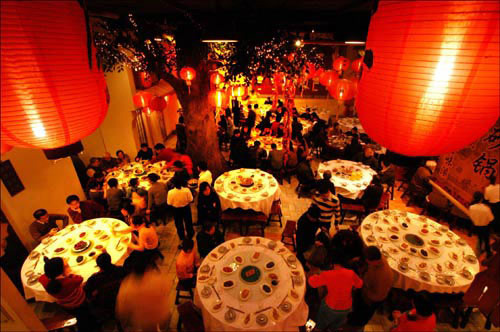 Turnip sculptures amaze tourists in Qingdao
Turnip sculptures amaze tourists in Qingdao Chinese ship formation conducts live fire training in West Pacific
Chinese ship formation conducts live fire training in West Pacific
 China comes in third at figure skating team event
China comes in third at figure skating team event
 China's teenager skater Yan shines at his Olympic debut
China's teenager skater Yan shines at his Olympic debut
 Taiwan-born actor stars on US TV series
Taiwan-born actor stars on US TV series
 Chinese Lunar New Year gift from abroad
Chinese Lunar New Year gift from abroad Chinese champions of Winter Olympic Games
Chinese champions of Winter Olympic Games  Zhang Yimou fined 7.48 mln for over-production
Zhang Yimou fined 7.48 mln for over-production
 Top 10 timeless female Chinese stars
Top 10 timeless female Chinese stars
WELLINGTON, Feb. 11 -- Valentine's Day, the international day for lovers, is causing a thorn in the side of New Zealand rose growers.
As the price of red roses shoots up, the country's Flower Growers Association (FGA) is calling on the nation's lovers to ask where their roses come from and urging the government to level the competition against subsidized imports.
FGA Chairman David Blewden said Tuesday that about half the 600, 000 roses sold for Valentine's Day would come from overseas -- mostly from the two main source countries of India and Colombia -- but they would also carry risks to New Zealand biosecurity, health and jobs.
Although the imports could be significantly cheaper than the locally grown blooms, buyers could be disappointed, Blewden told Xinhua in a phone interview.
"To get the imports into the country, the roses have to be dipped in a herbicide for 20 minutes -- that's going to kill the flower or potentially affect the vase-life," he said.
People who were sensitive to chemicals would also need to be careful when handling the flowers.
"If the buyer gets an unsatisfactory experience, they might lump New Zealand flowers into the same category and it would cost us sales."
Even with the herbicide treatment, the imports could still carry exotic pests and diseases that are a threat to New Zealand's wider horticulture sector and could undermine the local industry's preference for biological -- rather than chemical -- treatments.
While New Zealand growers faced a labor-intensive and "daunting " challenge in producing roses for Valentine's Day, growers in India were given "a lot of incentives and subsidies" from planting through to transport for exports, said Blewden.
"New Zealand flower growers are strong advocates for free trade, because we also export, but in this case, we don't believe there is a level playing field," he said.
While tariffs to compensate for foreign subsidies "would be nice," he said, he was not confident of any government action.
"A lot of the retailers are very concerned to be supporting the domestic flower industry, because potentially the domestic industry could be lost and they would have to rely on imports all year round, but they are also feeling the pinch from their competitors as well."
Blewden said the sale of roses was strongly influence by supply and demand.
He had heard that a bunch of 10 long-stem red roses had fetched more than 30 NZ dollars (25 U.S. dollars) at auction on Monday, but "tomorrow that might be 90 NZ dollars (75 U.S. dollars) or 100 NZ dollars (83 U.S. dollars)."
 Special Coverage: Sochi Winter Olympic Games
Special Coverage: Sochi Winter Olympic Games  A day of a female high-speed train chief attendant
A day of a female high-speed train chief attendant New Year greetings from Chinese nationals in Africa
New Year greetings from Chinese nationals in Africa PLA navy conducts landing drills in South China Sea
PLA navy conducts landing drills in South China Sea  Blind date fair in Hangzhou
Blind date fair in Hangzhou  Highlights of Chinese New Year celebrations around the world
Highlights of Chinese New Year celebrations around the world  How do the Chinese spend their money during Spring Festival?
How do the Chinese spend their money during Spring Festival? 'Milk Tea' girl hosts Spring Festival gala of universities in U.S.
'Milk Tea' girl hosts Spring Festival gala of universities in U.S.  Brave mother fights cancer, enjoys Spring Festival with her triplets
Brave mother fights cancer, enjoys Spring Festival with her triplets President Xi attends opening ceremony of Sochi Winter Olympics
President Xi attends opening ceremony of Sochi Winter Olympics Highlights of opening ceremony of Sochi Winter Olympic Games
Highlights of opening ceremony of Sochi Winter Olympic Games Snowscape in Chinese New Year
Snowscape in Chinese New Year Interesting horse figures in life
Interesting horse figures in life  Top 20 most beautiful Chinese stars
Top 20 most beautiful Chinese stars  Top 10 Chinese films in 2013
Top 10 Chinese films in 2013Day|Week|Month